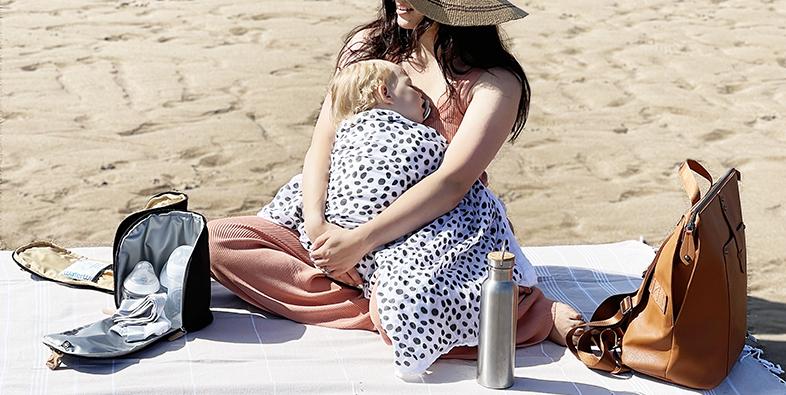
Making Memories: A Guide to Your Baby's First Beach Visit
Taking your baby to the beach for the first time can be an exciting and memorable experience. The sun, sand, and sea provide the perfect backdrop for creating lifelong memories with your little one. But before you pack up the sunscreen and beach toys, it's important to be prepared. In this guide, we'll walk you through everything you need to know to make your baby's first beach visit a success.
From choosing the right sunscreen to ensuring your baby stays hydrated in the sun, we've got you covered. We'll also provide tips for keeping your baby comfortable on the sand and in the water, so you can enjoy a fun and stress-free day at the beach. Plus, we'll share ideas for capturing those precious moments on camera, so you can treasure them forever.
Whether your baby is a water-loving adventurer or a little more hesitant about the beach, this guide will help you create a positive and enjoyable experience for both of you. Get ready to make unforgettable memories as you embark on this beach adventure with your little one. Let's dive in!
Visiting the beach with your baby for the first time can be an exciting and daunting experience. It's important to plan ahead to ensure a smooth and enjoyable outing for both you and your little one. Start by choosing the right beach location that is family-friendly and has amenities like restrooms, shaded areas, and easy access to the water. Consider the time of day as well, as the midday sun can be quite intense for a baby's delicate skin. Early morning or late afternoon visits may be more comfortable.
When planning your beach trip, take into account your baby's feeding and nap schedule. It's best to time your visit around these routine activities to minimize disruptions and keep your baby happy and content. Pack a cooler with your baby's favorite snacks, drinks, and any necessary feeding supplies. Don't forget to bring a comfortable, shaded spot for your baby to rest, such as a pop-up tent or beach umbrella. This will provide a safe and comfortable space for your little one to nap or play while you enjoy the beach.
Finally, consider the logistics of getting to and from the beach. If you're driving, make sure to pack a comfortable car seat and plan for any necessary stops along the way. If you're taking public transportation, research the options and plan your route in advance. Having a well-thought-out plan will help reduce stress and ensure a more enjoyable experience for you and your baby.

When packing for your baby's first beach visit, it's important to be prepared with all the necessary items to keep your little one safe, comfortable, and entertained. Start with the basics: a sturdy, waterproof diaper bag or backpack to carry everything you'll need. Inside, be sure to pack plenty of diapers, wipes, and a changing pad to ensure you can handle any diaper-related emergencies.
Clothing and sun protection are crucial for a beach outing. Pack lightweight, breathable clothing for your baby, such as a sun hat, long-sleeved shirts, and swim diapers or trunks. Don't forget the sunscreen! Choose a broad-spectrum, water-resistant sunscreen with an SPF of at least 30 and apply it generously to your baby's delicate skin. Bring a beach umbrella or pop-up tent to provide shade and keep your little one cool.
To keep your baby entertained and engaged, pack a selection of toys, books, and other activities. Consider bringing a beach blanket or mat for your baby to play on, as well as some age-appropriate toys like rattles, teethers, or soft, water-safe toys. You might also want to pack a portable speaker to play soothing music or lullabies. Don't forget to bring plenty of water and snacks to keep your baby hydrated and nourished throughout the day.
Safety should be the top priority when taking your baby to the beach. Start by choosing a beach with lifeguards on duty and avoid areas with strong currents or dangerous waves. When you arrive, scope out the area and identify any potential hazards, such as steep drop-offs or areas with sharp rocks or shells.
One of the most important safety considerations is sun protection. In addition to applying sunscreen, dress your baby in lightweight, long-sleeved clothing and a wide-brimmed hat to shield their delicate skin from the sun's harmful rays. Keep your baby in the shade as much as possible, using a beach umbrella or pop-up tent to create a cool, comfortable space.
When it comes to the water, never leave your baby unattended, even for a moment. Hold your baby securely in your arms or use a baby float or carrier designed for water use. Gradually introduce your baby to the ocean, starting with just their toes in the shallow water and gradually increasing their exposure as they become more comfortable. Keep a close eye on your baby at all times and be prepared to quickly remove them from the water if they become distressed or overwhelmed.
Introducing your baby to the ocean for the first time can be a magical and memorable experience, but it's important to do so gradually and with plenty of care and caution. Start by letting your baby dip their toes in the shallow water, observing their reaction and gauging their comfort level. Some babies may be delighted by the sensation of the waves lapping at their feet, while others may be hesitant or even fearful.
If your baby seems hesitant, try holding them in your arms and gently walking them into the water, keeping a firm grip and maintaining eye contact. Narrate what's happening, using a soothing, calming tone to help your baby feel safe and secure. As your baby becomes more comfortable, you can gradually increase the depth of the water, always keeping a close eye and ready to quickly remove them if they become upset.
When it comes to actually submerging your baby in the water, it's best to wait until they are older and more comfortable with the ocean environment. Infants have a natural reflex to hold their breath when their face is submerged, but this can be stressful and overwhelming for a young baby. Instead, focus on gently splashing water on your baby's face and body, allowing them to get used to the sensation. With time and patience, your baby will become more accustomed to the ocean and may even enjoy playing in the waves.
The beach offers a wealth of opportunities for engaging and entertaining your baby. One of the simplest and most enjoyable activities is simply letting your baby explore the sand. Provide a safe, shaded area for them to sit or lie down, and let them dig, sift, and play with the sand to their heart's content. You can even create small sand castles or shapes for your baby to discover and interact with.
If your baby is a little older and more mobile, consider bringing some beach-themed toys and games to keep them engaged. Soft, water-safe toys like rubber duckies or floating boats can be a hit in the shallow water, while building sandcastles or burying their toes in the sand can be a fun and tactile experience. You can also bring along a small bucket and shovel for them to use to scoop and pour the sand.
As your baby grows more comfortable with the ocean environment, you can introduce more active games and activities. Try gently splashing water on their feet or tossing a soft, lightweight ball in the shallow waves for them to chase. You can also encourage them to crawl or walk along the water's edge, supporting them as needed. Remember to keep a close eye on your baby at all times and be prepared to quickly intervene if they become overwhelmed or distressed.
One of the biggest challenges of taking your baby to the beach is ensuring their safety and comfort in the face of sun, sand, and water. Proper sun protection is crucial, so be sure to apply a generous amount of broad-spectrum, water-resistant sunscreen with an SPF of at least 30 before heading out. Reapply every two hours, or more frequently if your baby is in the water. Dress your baby in lightweight, long-sleeved clothing and a wide-brimmed hat to further shield their delicate skin.
Sand can also be a challenge, as it can get into your baby's eyes, mouth, and clothing, causing discomfort and potential irritation. To mitigate this, consider bringing a beach blanket or mat for your baby to play on, and be sure to wipe their hands and face regularly to remove any sand. You can also bring a small, handheld fan to gently blow sand away from your baby's face and body.
When it comes to water safety, never leave your baby unattended, even for a moment. Hold them securely in your arms or use a designated baby float or carrier designed for water use. Gradually introduce your baby to the ocean, starting with just their toes in the shallow water and gradually increasing their exposure as they become more comfortable. Be prepared to quickly remove your baby from the water if they become distressed or overwhelmed.
The beach offers a rich and stimulating environment for your baby's sensory development. From the feel of the sand between their toes to the sound of the crashing waves, the beach provides a wealth of new and exciting experiences for your little one to explore.
Encourage your baby to engage with the different textures and sensations at the beach. Let them dig their fingers into the soft, cool sand, or gently splash their hands in the shallow water. You can also bring along a variety of beach-themed toys and objects, such as seashells, smooth rocks, or even a small bucket of water, for your baby to touch, feel, and manipulate. This hands-on exploration will help stimulate their sense of touch and encourage their natural curiosity.
The sights and sounds of the beach can also be incredibly engaging for your baby. Encourage them to look up at the sky, watch the waves crashing, or observe the seagulls soaring overhead. You can also play calming, nature-inspired music or simply let them listen to the soothing sounds of the ocean. These sensory experiences will help stimulate your baby's visual and auditory development, as well as promote a sense of calm and relaxation.




